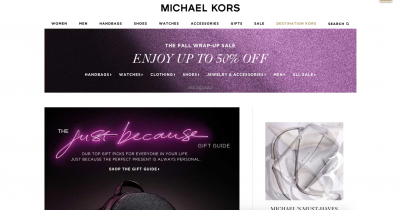 Online shopping is becoming more prevalent than ever. Image credit: Saks Fifth Avenue
Online shopping is becoming more prevalent than ever. Image credit: Saks Fifth Avenue
As digital continues to drive forward within retail, ecommerce spend is likely to reach $23 trillion this year.
A new report from Zmags has detailed that rich content on retailers' digital properties can help consumers make informed decisions on their purchases, acting as an in-store associate. It is important for ecommerce platforms to create an interactive and immersive experience for online shoppers.
Zmags partnered with NAPCO to create the report in which they surveyed 158 responses from retailers this June.
Online importance
Content creation is exceptionally important to online retailers, with 79 percent claiming that it is one of their top priorities or higher priorities.
 Michael Kors features rich content
Rich content is also highly important, with 70 percent of digital retailers creating at least one or two rich pieces of content per month. Retailers are creating various interactive pieces of content such as look books, buying guides, videos and user generated content.
Nineteen percent produce up to five pieces of rich content per month.
The least popular form of interactive content seems to be online quizzes, with more than 60 percent of retailers having never produced one. Animations follow second at 50 percent.
More than 45 percent of retailers use a responsive design, which adapts to mobile devices to make the experience better, as mobile shopping is becoming more popular.
Almost 55 percent are interested in featuring more themed content such as holiday-focused content and how-tos.
Rich content is not only effective in attracting consumers but it is important in staying current with competitors. Now that rich content has become an industry standard, 32 percent of retailers say they use it stay competitive and is the top reason for doing so.
However, the biggest concern with developing rich content is that it is too labor intensive, with 57 percent thinking it is too much work.
Michael Kors features rich content
Rich content is also highly important, with 70 percent of digital retailers creating at least one or two rich pieces of content per month. Retailers are creating various interactive pieces of content such as look books, buying guides, videos and user generated content.
Nineteen percent produce up to five pieces of rich content per month.
The least popular form of interactive content seems to be online quizzes, with more than 60 percent of retailers having never produced one. Animations follow second at 50 percent.
More than 45 percent of retailers use a responsive design, which adapts to mobile devices to make the experience better, as mobile shopping is becoming more popular.
Almost 55 percent are interested in featuring more themed content such as holiday-focused content and how-tos.
Rich content is not only effective in attracting consumers but it is important in staying current with competitors. Now that rich content has become an industry standard, 32 percent of retailers say they use it stay competitive and is the top reason for doing so.
However, the biggest concern with developing rich content is that it is too labor intensive, with 57 percent thinking it is too much work.
 Gieves & Hawkes ecommerce site
Most online retailers are using their Web sites to provide content to consumers with 85 percent saying so, and 68 claiming to use social media to do so.
Digital retail insight
Successful international ecommerce strategies go beyond translating a Web site into consumers’ local languages, according to another report from L2.
Cross-border ecommerce opens up brands to shoppers in countries that are growing more rapidly than established, saturated markets such as the United States and Europe, but retailers should do their due diligence before making a move. To make headway with global consumers, localization efforts should deliver both market-specific content and commerce features (see more).
L2 also showed luxury is one of the top three sectors for international ecommerce, and that share is likely to swell as desire for cross-border luxury goods grows.
As more brands offer options for international shipping and local currency purchasing, luxury consumers are beginning to expect a certain level of convenience to cross-border ecommerce. The luxury brands that encourage this expectation and rise to meet it will be most successful (see more).
Gieves & Hawkes ecommerce site
Most online retailers are using their Web sites to provide content to consumers with 85 percent saying so, and 68 claiming to use social media to do so.
Digital retail insight
Successful international ecommerce strategies go beyond translating a Web site into consumers’ local languages, according to another report from L2.
Cross-border ecommerce opens up brands to shoppers in countries that are growing more rapidly than established, saturated markets such as the United States and Europe, but retailers should do their due diligence before making a move. To make headway with global consumers, localization efforts should deliver both market-specific content and commerce features (see more).
L2 also showed luxury is one of the top three sectors for international ecommerce, and that share is likely to swell as desire for cross-border luxury goods grows.
As more brands offer options for international shipping and local currency purchasing, luxury consumers are beginning to expect a certain level of convenience to cross-border ecommerce. The luxury brands that encourage this expectation and rise to meet it will be most successful (see more).
